
Traveling Through History
Issue 32 - European Vacation - Bad Hersfeld, Germany
In December 1977 we traveled to the birthplace of my mother for Christmas.
It was the first time she had been back to her ‘village’ since she migrated as a 15 year old with her family in 1954.
They traveled on the Castel Felice, an ocean voyage that would take almost a month.
When they arrived in Australia, they stayed in the Bonegilla Migration Camp in Victoria, before eventually moving to Woodside in South Australia, ahead of building a house in Port Adelaide.
This issue will feature mum’s birthplace, Bad Hersfeld, where we visited at the end of 2023 and a trip back to Bonegilla that we did in 2020.
For an historian, family history is just as important as any World events. Obviously, some families have incredible, or complicated, or tragic histories.
Some, like ours, were just that of working class parents, who wanted a better life for them and their children and decided to bet that that life resided elsewhere.
Without migrating to Australia, my mum would not have met my dad and I would not have been born. So I guess for me, it was a lucky thing.
I hope you enjoy Traveling Through (a personal) History with me this week.
Michelle
Savvy Travel Historian

Bad Hersfeld, is a small town in the state of Hesse, Germany.
It has a rich history that dates back to its foundation in the 8th century but settlement history of the area can be traced back to about 2000 BC during the New Stone Age, with a discovery of a Bronze Age grave from about 1200 BC also unearthed.
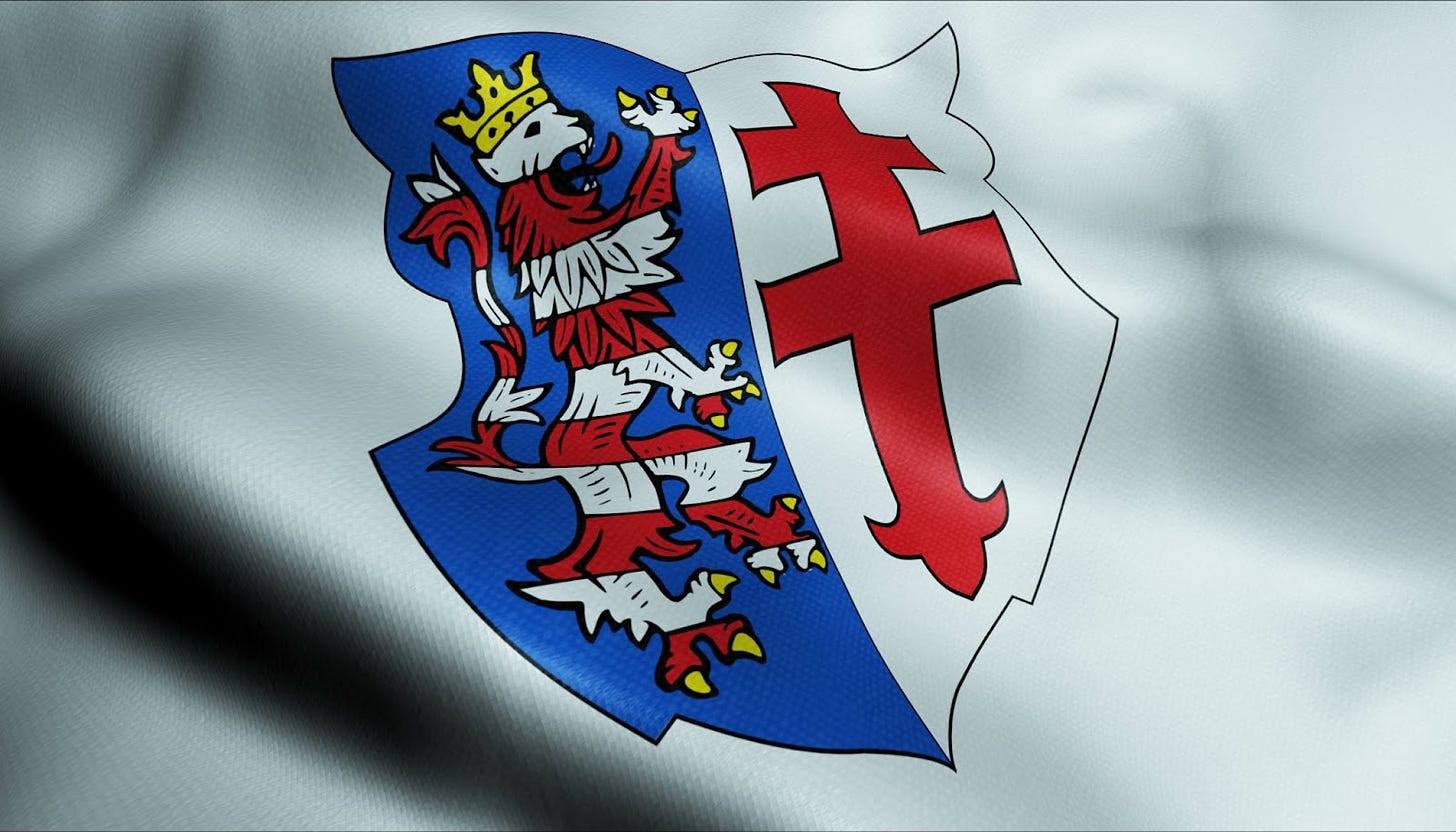
The town’s coat-of-arms (shown above) has been used since 1559.
The ‘double cross’ represents the Abbey and the Lion of Hesse appeared in the town's arms after the conquest in the Peasants’ War from Philip I, Landgrave of Hesse, in 1525.
Bad Hersfeld lies around 140 kms north-west of Frankfurt and via the autobahn, approximately 1.5hrs drive.

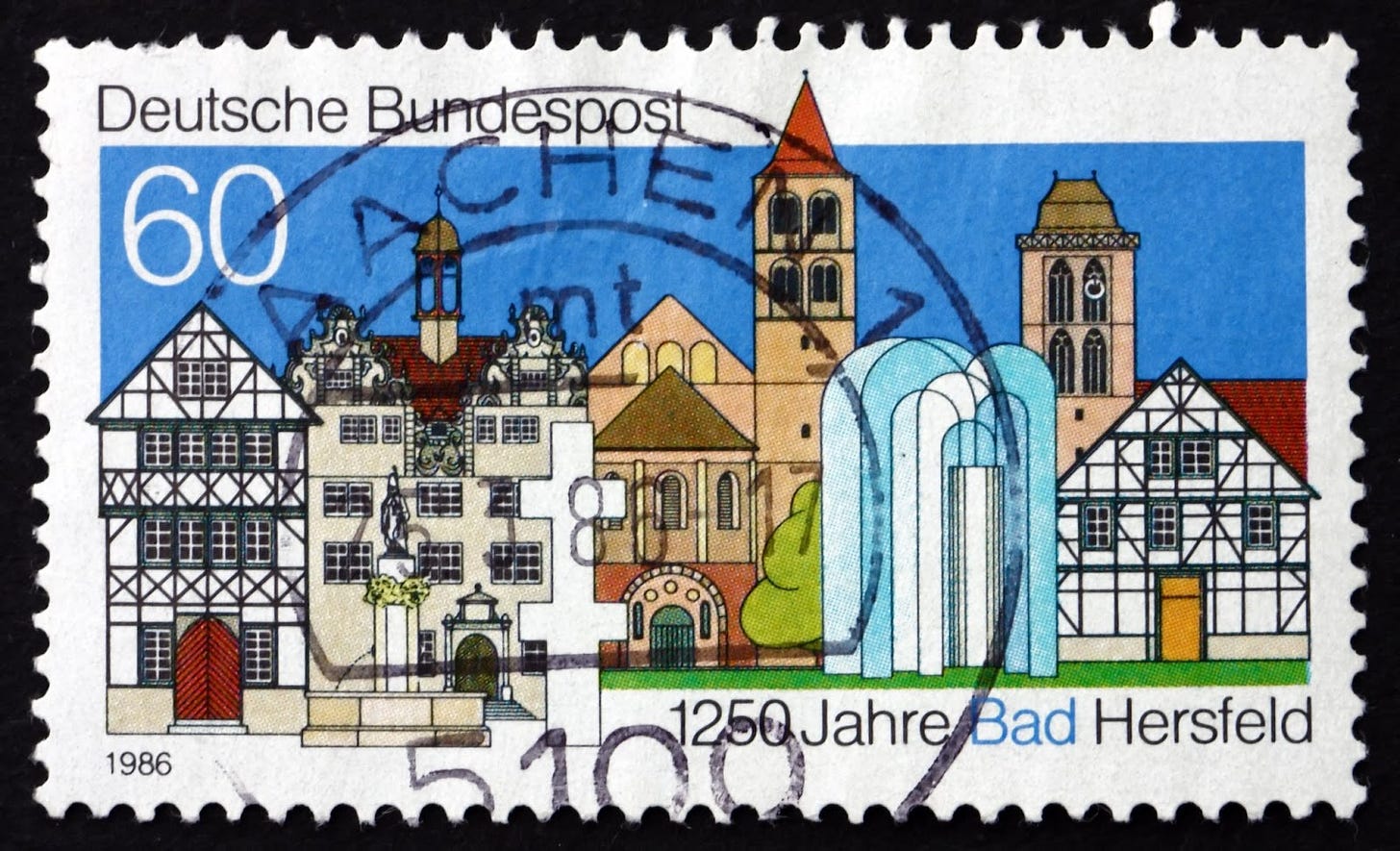
The town's origins are closely tied to Hersfeld Abbey, a Benedictine monastery founded in 736 by Saint Strum, a disciple of Saint Boniface but he relocated it to the nearby town of Fulda. St Lullus would re-establish it in 769 which marks the town's significance.
The 9thC and 10thC marked a period of significant growth for Bad Hersfeld, as it became a centre for culture and learning, benefiting from the Carolingian Renaissance.


Saint Lullus was an Anglo-Saxon missionary who played a significant role in the Christianisation of the Germanic tribes during the 8thC. His life and work are particularly associated with the area that is now Germany.
Born in England around the year 710, Lullus was a disciple of Saint Boniface, who is often called the Apostle of the Germans. Lullus accompanied Boniface on his missions to the Germanic peoples and was deeply involved in the Christian missionary work in this region.
One of his most notable achievements was succeeding Boniface as the Archbishop of Mainz after Boniface's martyrdom in 754. As Archbishop, Lullus continued Boniface's mission of organising and reforming the church in the Frankish Empire.
He was known for his efforts in building churches and monasteries, including the famous Hersfeld Abbey in Bad Hersfeld (now referred to as the Stiftsruine), which he founded around 769. It would become one of the most influential Benedictine abbeys in Germany.
Saint Lullus died on October 16, 786, in Hersfeld. He was venerated as a saint after his death, and his feast day is celebrated on October 16th.
Lullusfest, is held in Bad Hersfeld each year and is a significant festival that marks the anniversary of his death. It is the oldest folk festival in Germany having been held since 852!!! (yes over 1100 years!).
Further information on the festival can be found here.

In the 20th century, Bad Hersfeld was significantly affected by both World Wars.
Post-World War II, it found itself in the American occupation zone and underwent a period of reconstruction and modernisation. This era also saw the town developing into a spa destination, utilising its rich thermal springs, which led to the addition of ‘Bad’ to its name, signifying a spa town.
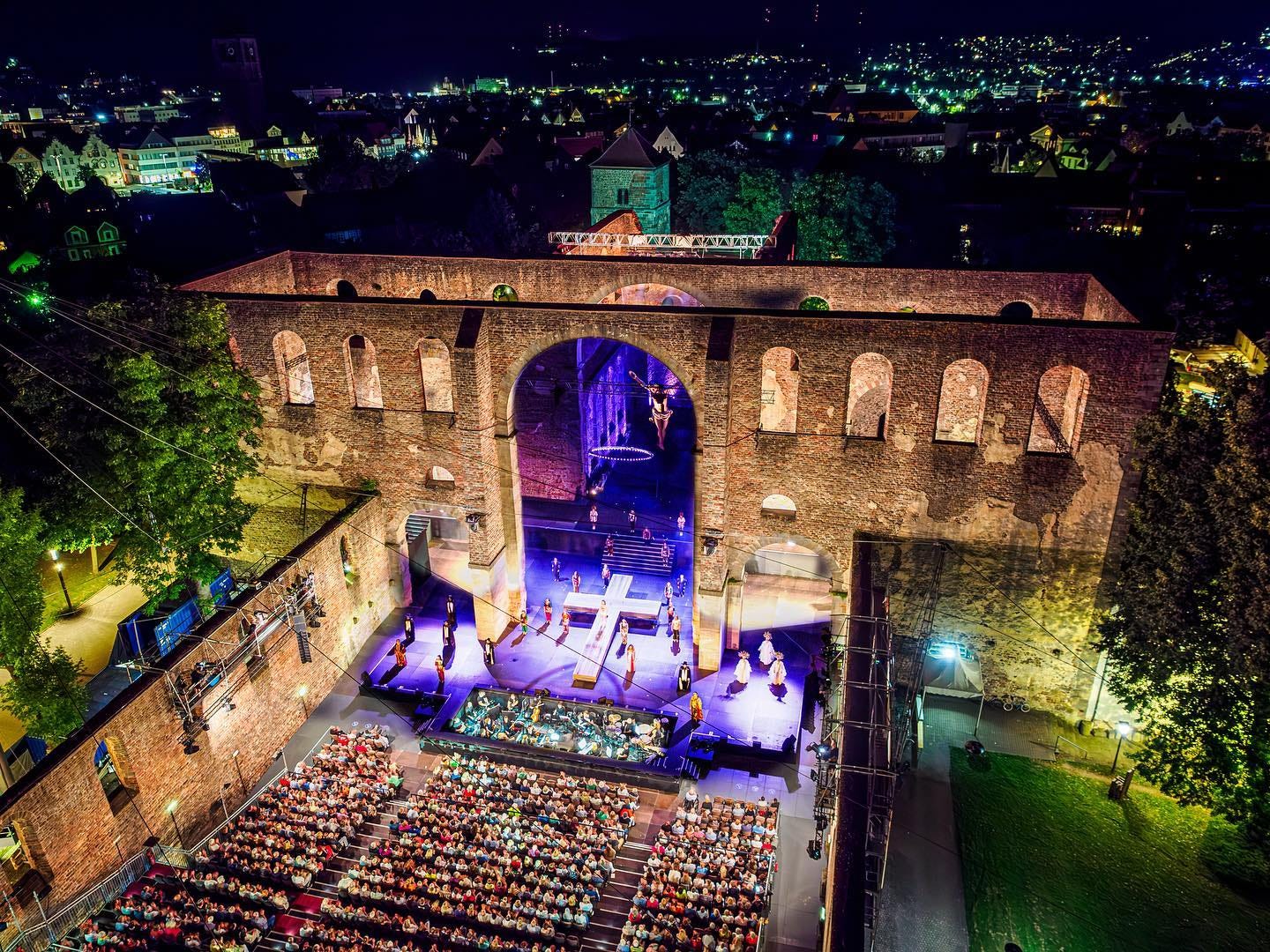
Today, Bad Hersfeld is known for its well-preserved historical architecture, including the ruins of the Stiftsruine, which serve as a stunning backdrop for the Bad Hersfelder Festspiele, an annual festival of plays.
The festival has been held since 1951 and will be 73 years old in 2024.
As can be seen from the image above, the Stiftsruine is turned into a ‘theatre’, with staging and tiered seating for the many performances. Some of the best artistic directors in Germany are invited to arrange and present the festival, as Director, each year.
More details can be found here:
https://www.bad-hersfelder-festspiele.de/
Martin Luther, the seminal figure of the Protestant Reformation, had a significant connection with Bad Hersfeld, when he visited the town in 1521, on his journey back from the Diet of Worms. He had been called to appear at the Diet, to defend his teachings against the Catholic Church.

Luther’s ideas and his calls for reforms resonated with many of the local clergy and laity in the region. This led to a gradual shift in religious practices and beliefs in the town and surrounding areas and within two years they would be mostly Protestant.
Luther gives a detailed account of his time there:
You would not believe the tremendous kindness with which the abbot of [Bad] Hersfeld received us. He sent the chancellor and the treasurer to meet us a good mile in advance. Then, once he had received us at his castle with many horsemen, he himself accompanied us into the city. The city council received us once we entered the gates. In his abbey he fed us sumptuously, and he put me up in his own bedroom. At five in the morning they compelled me to give a sermon, even though I pleaded in vain that I did not want the abbey to risk losing its imperial privileges, should the imperial officials set about to interpret this act as a breach of the safe conduct I had been given, since they were restraining me from preaching on the way home. I nevertheless told them that I had not agreed to the word of God being chained, which is also true.
Part of Luther’s ‘strategy’ during what was to become known as the Protestant Reformation, was to preach in small towns and villages, that not only sold the many pamphlets he printed, but also assisted with the ‘grassroots’ nature of the Reformation. Another reason to choose Bad Hersfeld was that it is believed that the abbot, Heinrich Fuchs, was one of the first priests to marry, which was against the Catholic Church’s teachings.
The impact of Luther on the region can still be seen today, over 500 years later.

The Luther Trail, known in German as ‘Lutherweg’, is a network of walking and pilgrimage paths that trace the footsteps of Martin Luther. This trail spans several regions in Germany, particularly in the states of Saxony, Saxony-Anhalt, Thuringia, and Hesse, areas deeply connected to Luther's life and the history of the Reformation and includes Bad Hersfeld.
The Luther Trail is not only a testament to Martin Luther's profound influence on religion and society but also a means for modern-day explorers to engage with history, culture, and spirituality in a uniquely immersive way. It attracts thousands of visitors annually, ranging from religious pilgrims to history enthusiasts and outdoor adventurers.
Luther's stop in Bad Hersfeld was significant at the time. The abbey, a center of Catholic religious life, was encountering the growing influence of Reformation ideas and his presence in Bad Hersfeld was pivotal to the spreading Reformation, symbolising the challenge to the Catholic Church's authority and the shifting religious landscape in Germany. Luther's visit to the Stiftsruine, therefore, stands as a noteworthy moment in the town's history.

The town has around 30,600 residents but increases significantly during the various festivals that take place each year.

The ‘Stadtkirche’ - (City Church), with its imposing 14thC tower is the ‘old’ town’s main landmark.

The town is centrally located in the north-east of Germany and it has attracted many big companies that provide employment to the people of the area.
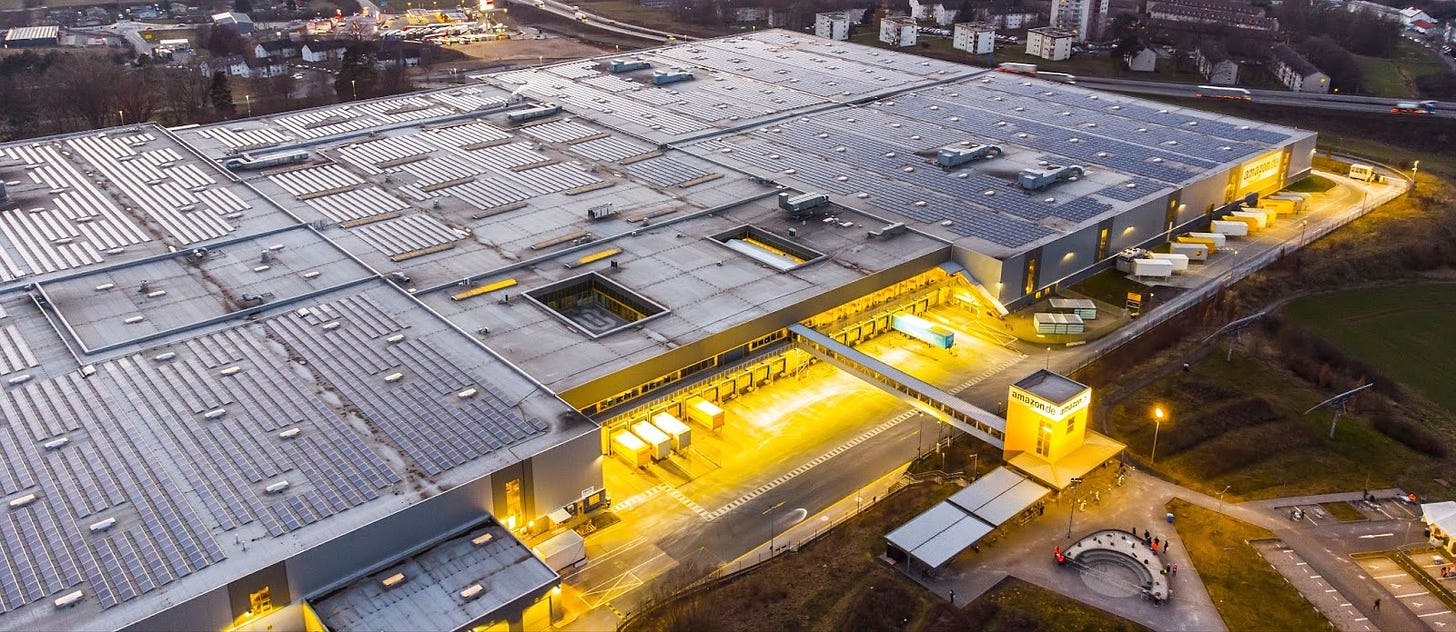
In 1999, Amazon opened the first of its fulfillment centres on the outskirts of the town. It is the largest in Germany. In 2009 they opened a second one. Although it brought employment, workers have been unhappy with their employment practices and there have been strikes on and off for many years, with seemingly no resolution.

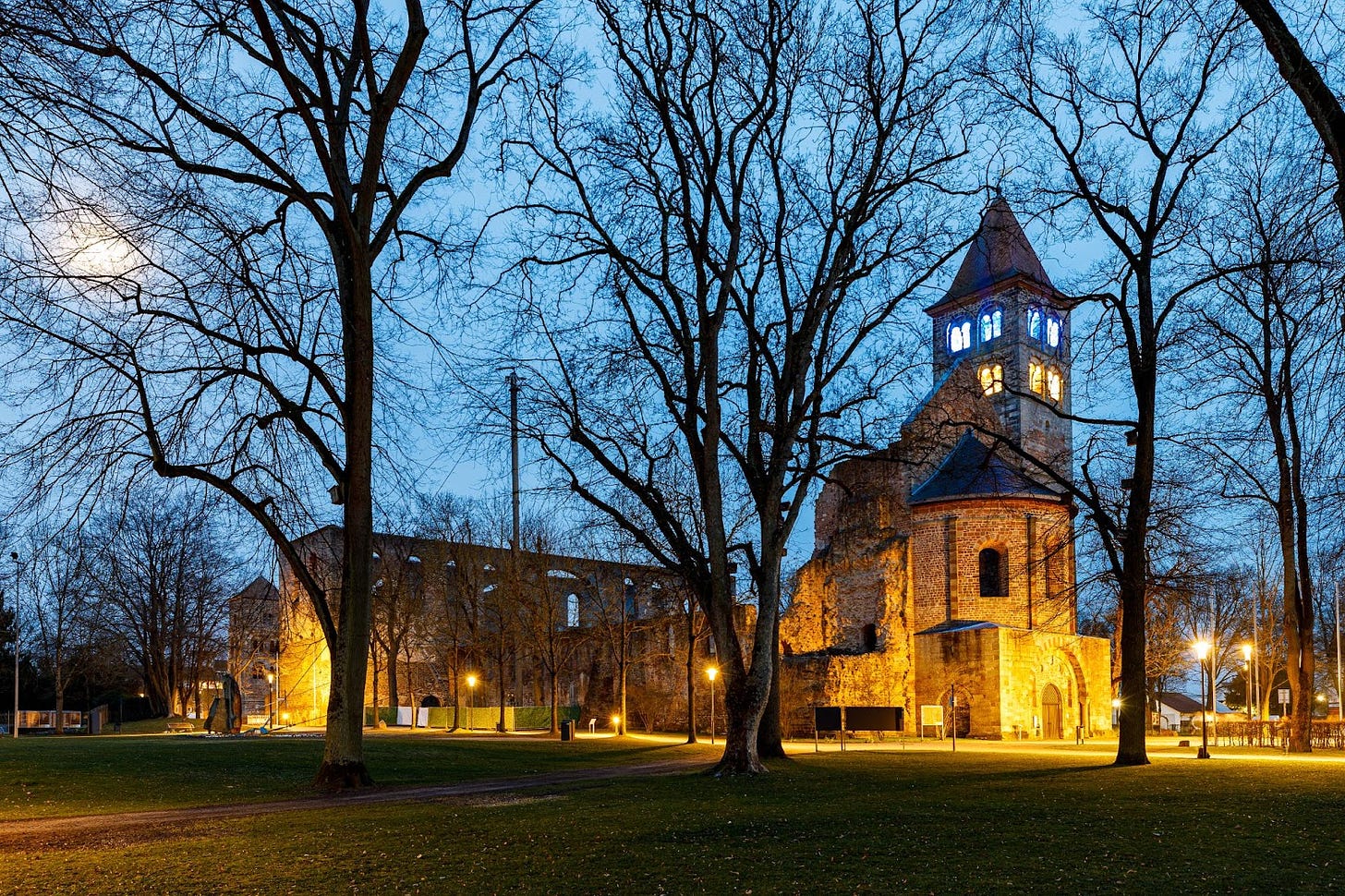
Religious history can be traced back to this site for almost 1300 years. There were four previous buildings on the site but the current structures are the largest European monastic ruins in existence.

The town’s museum is housed in the only surviving wing of the former monastery. It includes not only the history of Bad Hersfeld but also the monastery and is well worth a visit. It is free, they only ask for a donation when you leave.

https://museen.bad-hersfeld.de/museum-stadt-bad-hersfeld.html

Within St Catherine’s Tower is the LullusGlocke, the oldest dated cast bell, hanging without interruption in Germany, and is still rung on special occasions.

It was cast in 1038 and was originally hung above the transept of the monastery church, but was relocated in 1585, which saved it from the fire that ravaged the monastery in 1761 during the Seven Years War.
In 1941 my mother was born in Bad Hersfeld. Her family lived in the old town and mum was happy to return to see her childhood home.

Multiple generations of her family lived there. Her parents, grandmother and her uncle. The house is now occupied by an elderly woman on her own. Mum was shocked to see she had all those levels and rooms to herself!

My mother’s father was in the German Army and was killed during the Battle of Stalingrad.

My grandmother eventually re-married in the church right around the corner and it felt like a real ‘connection’ for us to visit it together as a family.

When my grandparents migrated in 1954, they would not return to Bad Hersfeld until 1976. Their homecoming was significant enough to make the local paper, as they stepped off the train at the railway station!
We all enjoyed our time together there, although it was too short and my mum enjoyed it much more than she thought she would, after a 40 year absence.


Bonegilla Migrant Camp is located around 15 minutes east of Wodonga in Victoria, Australia, which is a 3hr, 20 minute drive north-east of Melbourne.

Between 1947 and 1971, over 300,000 displaced or homeless persons came to Australia to make a new home. These Europeans were from the countries most ravaged by the Second World War, all looking for a better life.
The Bonegilla camp was a former army barracks and its main function was to process and house migrants. It was to provide work and give the new settlers English lessons and tutoring in the ‘Australian way of life’.
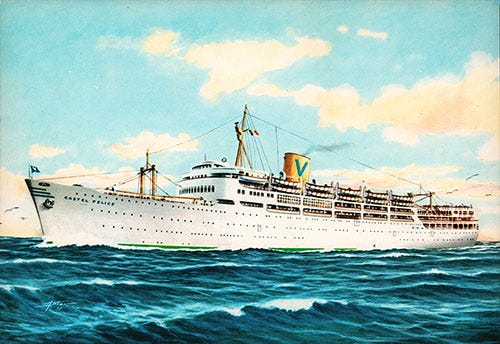
My grandparents and their children traveled the month-long journey on the Castel Felice arriving in November 1954.


Each arrival was recorded on cards that are now part of the National Archives. Like many others, my family’s arrival is recorded as shown below.

In exchange for the chance to start a new life, my grandfather had to work for the Australian Government for two years and he worked on the building of the Port August to Adelaide Railway (in South Australia) and they did not see him for many months, after he was sent off to work.
They would eventually be relocated to Woodside Camp in the Adelaide Hills and it was in South Australia they settled as a family and how my mum met my dad in the early 1960s.
Today, ‘Block 19’ of the migrant camp has been preserved as a museum experience (or ‘memory place’), for people to visit. Originally there were 24 different ‘blocks’, which included churches, hospital, cinema, police station, school and sporting fields.

Bonegilla was the largest and longest running facility of the post-war era. Most migrants were from non-English speaking backgrounds. For some the journey was exciting, to start a new (and better life) but for some, it was a confusing and lonely time.

Dining Halls and canteens were one of the main ways to socialise, with the weekly menu being the same for each day of the week.
Many migrants recall being able to tell what day of the week it was, just by seeing what they were having for dinner that night!

The National Heritage listed site, is an important record of people’s written, oral and pictorial histories and this small, preserved section, is a way of honouring the multicultural diversity of Australia and the migrants who contributed to its rich history.


Michelle is a speaker, author, content marketer, historian and mother of 3 boys.
After 25 years in business and as the ‘Content Marketing Queen’ for the past 12 years, she has helped countless small businesses understand and develop their content strategies and focus on a customer first approach.
Savvy Travel Historian is her passion project, and her weekly newsletter is available on Substack, Paragraph and Mirror. The latter two allows you to collect each Issue as an NFT.
Michelle is co-host of the Business on the Bloc podcast, a weekly show which talks about the digital media revolution and how it applies to B2B marketing, sales and operations. The show is recorded live every Wednesday at 4pm EST/ 9pm UTC on LinkedIn, YouTube & Bolt+.
You can follow Michelle in these places:
Savvy Travel Historian Instagram
